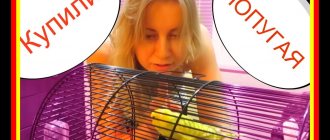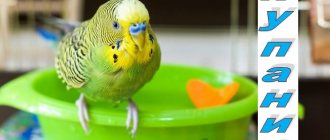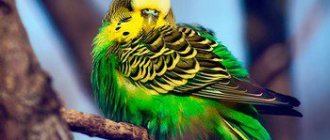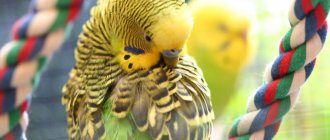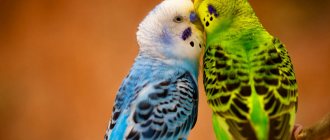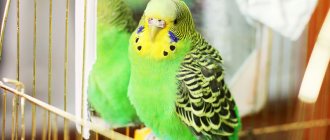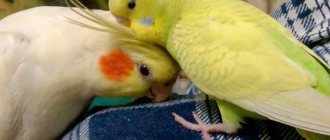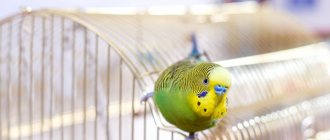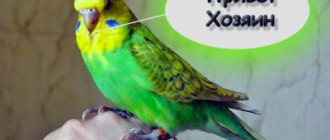We bought a bird - what to do next?
The first thing you need to take care of to adapt your budgie after purchasing it is the cage. It should be spacious enough and safe. The classic version of the cage is a wooden frame and metal rods. The minimum dimensions of a parrot house are 60 cm length, 50 cm height and 35 cm width. For a more comfortable stay, these parameters should be increased by one and a half times.
It is more practical to look for a cage with a retractable bottom. Structures of this type are much easier to maintain. In addition, the bird will not experience stress at the sight of human hands with a broom flickering around the cage.
Housing for a pet must be equipped with a drinking bowl, feeder, bathing area and perches. Three crossbars are enough for one bird, one of which will act as a perch.
How many parrots do you have?
12
You also need to find a good place for the cage. Drafts and direct sunlight should be excluded. But you can’t put it in a heavily shaded corner either. The optimal place is next to the wall, not far from the window and at eye level of the owner.
The microclimate is also important for the pet’s adaptation. Comfortable temperature for budgies is +25⁰С. The cage should be kept away from noisy household appliances such as a TV, radio or washing machine. They will cause stress in the bird.
You cannot move the cage during the habituation period . The pet must get used to the environment by becoming familiar with the interior items around it. This will play an important role during the first flights in the new premises.
A newly purchased cage should be thoroughly washed and disinfected. This can be done either using regular laundry soap or using specialized pharmaceutical preparations. Local accessories also need disinfection.
Adaptation of a budgerigar lasts from one to three weeks, depending on external conditions, the behavior of the owners, and the character of the bird.
How to behave further with a parrot
It is possible to keep a parrot without a mate, but a person will need to regularly keep his pet company - talk to him, feed him treats, show attention. A few additional recommendations for already established parrots and their owners:
- After a week of keeping, you can accustom the bird to handling. This will take approximately five to seven days, depending on the bird's temperament.
- During this time, you can already understand which fruits or nuts the parrot loves most. It is advisable not to give treats “just like that”, but to use them for accustoming to hands, in the form of a reward for some “achievements” - for example, for sitting on the palm or trying to imitate the owner’s voice.
- In the third or fourth week, you can try letting the parrot out of the cage. By this moment, he should already perceive his habitat as home, that is, he should be happy to return there.
- You cannot feed outside the cage. The budgerigar should associate this place with food, so he will willingly fly to his perch.
Parrots are easily tamed and willingly become close friends of humans. The main thing is not to rush things, taking into account the individual characteristics of each bird.
How does the bird behave during the first days?
At first, the pet will experience severe stress. It depends on the owner how quickly the parrot can overcome it.
Each bird reacts to a new place in its own way. Some individuals huddle in a corner and sit with frightened eyes, others rush around the cage trying to get out, and still others behave as if nothing had happened.
It is advisable to create a quiet and calm environment in the room, at least for the first few days, and also to limit the parrot’s social circle to only the owner. If there are other animals in the apartment, then you cannot let them into the same room as the bird.
How to choose a young parrot
Acceptable age is from 4 to 8 weeks. The best chicks come only from breeders. And the best breeders are those who (no matter how strange it may sound) take the chicks away from their parents and feed them themselves.
This is only beneficial for a young parrot: they perceive a person as their mother (or father, it doesn’t matter). And then he will believe that people are also parrots
Well, or he will classify himself as a member of the human race. Therefore, there are no problems with such individuals; there is no need to tame them and seek friendship and reciprocity from them.
Externally, the bird should be healthy, and this is:
- neat appearance and clean feathers;
- no damage or redness in the cloaca area;
- whole beak and claws.
A healthy chick is inquisitive, it has a good appetite, which remains even after moving to a new owner (young animals tolerate stress more easily and quickly than older individuals).
Dull eyes, lethargy, discharge from the nostrils and cloaca, frizz and silence, plucked feathers should alert you.
When to worry
Many owners begin to sound the alarm when the parrot does not behave as it should in the first days. What adds to the panic is the fact that his behavior was different at the pet store. The owner thinks that the pet is sick with something and may die. In a good half of cases, the cause of all problems is the adaptation period.
The parrot doesn't eat
One of the first signs of stress is poor appetite or no appetite at all. The pet may not touch food for more than a day. Then, due to hunger, he will gradually begin to eat. Sometimes, as a result of stress, the bird simply does not see the feeder, so it is worth pouring the grain directly onto the tray.
Doesn't drink
Just as in the case of food, a parrot can last about a day without water. To find out whether your pet approached the drinking bowl, you should leave marks on the container with a marker. If the level does not drop, then place a large saucer on the tray and fill it to the brim with water.
rushing about
If the bird is rushing around the cage, then there is no need to calm it down. This will only make the stressful situation worse. The pet must come to its senses on its own. The main thing is to provide him with food and water, and also to exclude loud noises. As a rule, parrots calm down in less than 8 hours.
Sits motionless
Very often, when a bird finds itself in a new place, it tries to find a reliable corner where it could wait out its stressful state. Unlike the previous case, apathy can last for several days. Here it is also important not to disturb the pet and let it get used to its surroundings.
Possible problems encountered after purchase
An experienced poultry farmer will determine the severity of the problem, and a beginner will think that his first pet may die or be seriously ill when, in the first days after the housewarming, the bird behaves differently than it did in a pet store when purchased.
We bought a budgie. Day 1: Adaptation
The parrot has liquid droppings
It’s okay if the wavy has loose stools for the first 2-3 days. Due to nervousness, diarrhea visits not only birds, but also animals - and even us, the crown of creation. Therefore, let him get comfortable, do not disturb or disturb him. There is no need to try to forcefully “wipe your pet’s butt” - nothing will happen to him if the cloaca is a little dirty for some time. This is better than for the parrot to think that evil people want to kill him. Then the matter will not be limited to just diarrhea.
Doesn't eat
A common sign of stress is lack of appetite. Food may remain untouched for 1-2 days. And then the golden rule “hunger is not an aunt” comes into force. Just in case, just sprinkle the grains on the floor (it must, of course, be clean) - in case the parrot simply didn’t find a feeder in its new home.
The parrot doesn't drink
It is not fatal if the bird does not drink for a day. You can play it safe by placing a saucer of water at the bottom of the cage. And try to make a mark on the drinking bowl to understand whether the water level is decreasing and by how much. These birds drink quite a bit, so don't panic.

